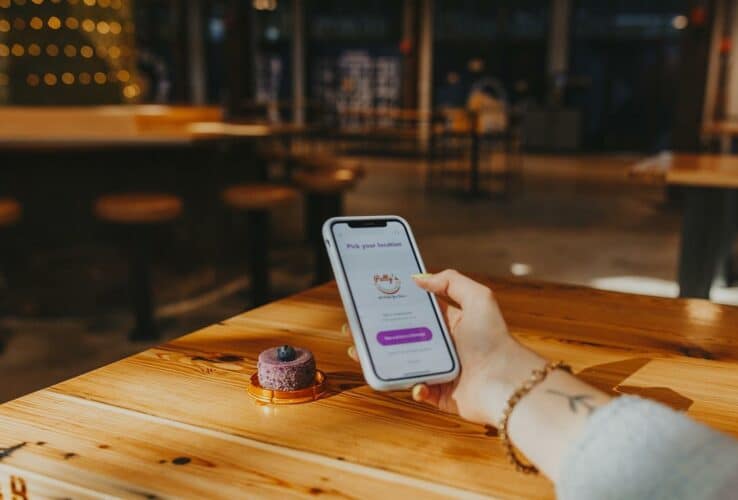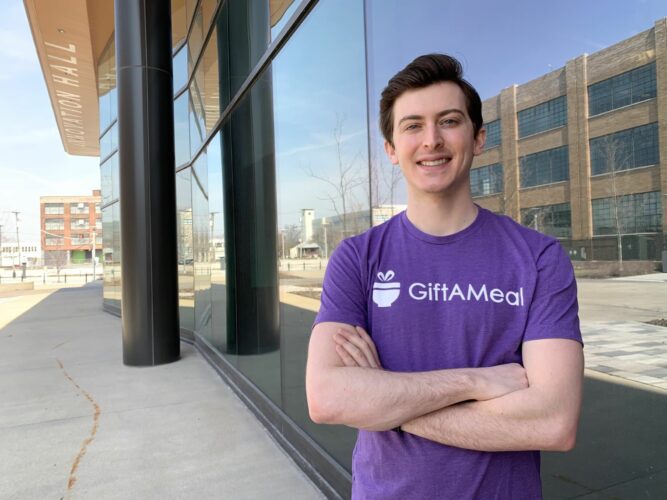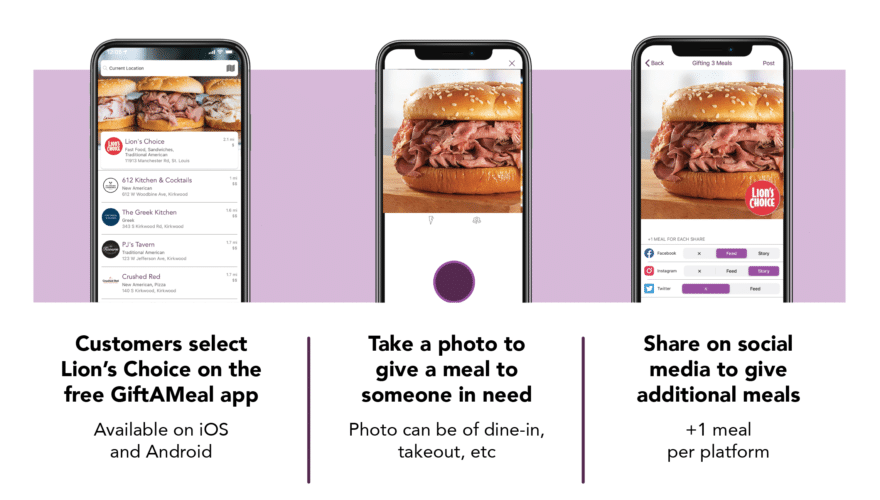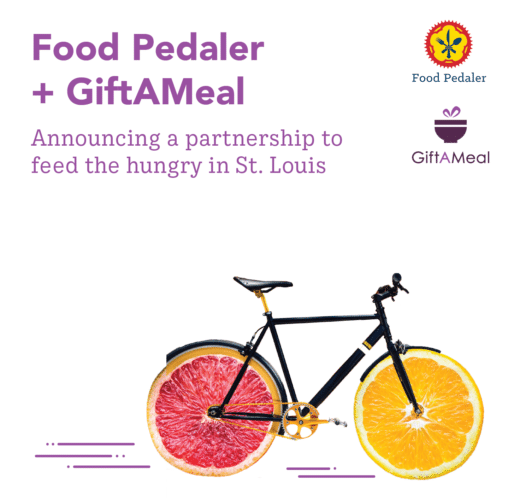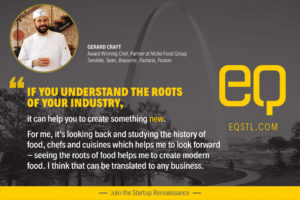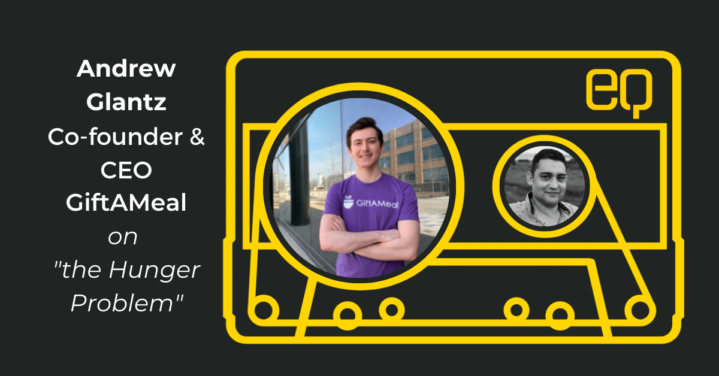
Solving the Hunger Problem and Making a Difference with Slacktivism
Jonathan Allen: So I’m with Andrew Glantz from GiftaMeal, a startup you’ll have heard about a lot on EQ and in St. Louis. They’ve been active since 2016; won dozens of prizes and have also raised funds from Arch Grants, Capital Innovators and some angel investors to the tune of over $250,000 and you guys have just recently launched a report that shows the impact of GiftaMeal on restaurant loyalty. Give our listeners just of overview of GiftaMeal, the food photos concept and then tell us about the study.
Andrew Glantz: [00:39] Yeah, of course. So, the basic idea of GiftaMeal is that it’s a mobile app and each time someone takes a photo at one of our partner restaurants, we make a donation to a local food bank to help give a meal to someone in need. And if the user then shares their photo on Facebook or Instagram, we give a second or third meal aswell.
From the business’s side, the restaurants are paying GiftaMeal, a monthly subscription to be on the app, as a mix of marketing and giving back. So that’s where the money comes from. And then with each photo taken, we make a donation to the food bank to help them distribute one meal of food, or 1.2 pounds of groceries to a local pantry where somebody in need can actually access it in their neighborhood.
So, currently, we have a little over 175 partner restaurants on the app, over 150 of which are in St. Louis. And we have over 31,000 people on the app and have given over 362,000 meals to those in need so far.
JA: [01:32] So, 175 partner restaurants. How much are you donating on average at the current run rate every month to Operation Food Search?
AG: [01:42] Yeah. So Operation Food Search is our food bank partner in St. Louis. We’re also in Chicago with Lakeview pantry and Detroit with Forgotten Harvest. So, in an average month, we’re donating about $1700/$1800 per month to the food banks.
JA: [01:56] Right. Brilliant. And that number is growing.
AG: [01:58] Yes, absolutely. I mean if you looked at where we were a year ago, we provided about 180,000 meals and now we’re at 362,000 meals so, yeah, as we get more restaurants on the app and more users taking photos, then we’re able to exponentially increase the amount that we can donate every month.
JA: [02:14] Right. And, yeah, your latest study proves the value of restaurants joining GiftaMeal and supporting the app with their customers and promoting it. Can you tell us a bit about what the study revealed?
AG: [02:27] Yeah, absolutely. So, in general, the restaurants are joining GiftaMeal as an easy way to give back and then also to help drive customers to their restaurant and improve their experience.
So we just completed a 14 month case study with the Clayton restaurant, Pastaria, owned by Gerard Craft. What we did is we matched the names on their credit cards of the people used at Pastaria to the names of the GiftaMeal accounts. So we could have a segment of customers that used GiftaMeal and ones that did not.
In comparing the payment data of those two groups, we saw that the customers that used GiftaMeal were returning 3.8 times more frequently than customers that did not use GiftaMeal. And so that led to an extra per customer on average, over $400 of extra sales for Pastaria over the course of those visits by each customer; since they were returning more frequently and also, on average, they are spending a little bit more as well, per check. So that was something that was really, really great to see.
We also saw what people were saying about Pastaria was exclusively positive. So a lot of restaurants don’t like Yelp and public reviews and stuff like that. GiftaMeal doesn’t have reviews; it’s just posting the photos with captions. And all the captions were positive about Pastaria: like the most frequently used words were “delicious” and “best” and “pasta” and “gelato”, stuff like that. And so it was really, really great to see GiftaMeal used as a really uplifting thing at the restaurant. We provided over a thousand meals to those in need during those 14 months at Pastaria.
So making a big impact, getting them a ton of positive publicity with people posting photos and saying great things; and then also leading to actually increased visits and business results for Pastaria.
JA: [04:13] What’s interesting is that GiftaMeal users are happy eaters. You seem to be collecting a foodie audience. But what I find really fascinating is that actually there’s lots of foodies on the internet in general, nowadays, and lots of apps for discovery of food options and things like that, but GiftaMeal has this social cause built in, which is “practical slacktivism” that GiftaMeal users enjoy . They’re both foodies and committed to causes.
AG: [04:51] Yeah. We did a survey of our users that had about 400 respondents and we asked them a variety of questions and 79% of the users reported, they dine out at least once a week.
So yeah, like you said, they’re foodies, they’re dining out frequently. And then we also split that up based on people that use the app zero times, they just downloaded it and hadn’t used it in a restaurant yet. One time two times, three plus times. And what was interesting is the more frequently somebody used GiftaMeal, the more likely they were to dine out more frequently, which makes sense, but also they were more likely to have reported to be donating to charity recently and volunteering more. So yeah, the people that use gift a meal are actively going out to restaurants and then they also care about giving back.
That’s actually a sweet spot we hit. What’s also interesting is about 60% of our user base is millennial, so you know, core base is 25 to 34 year olds is the most of the people that use the app. But still that’s over 40% of our user base is over the age of 35 and we see that there’s a ton of super active users that are [age] 55+. They’re using GiftaMeal every time they’re dining out. And so something that’s really important to us at GiftaMeal is making the app super easy for everybody to use and not just saying it’s for the millennial foodie, who’s taking pictures of food, but it can be for somebody that’s 75 years old and has 10 apps on their phone. We wanted to make it a way that anybody could easily give back.
JA: [06:19] This whole idea of like “easily giving back”—you know— I used the word slacktivism earlier. It’s like slacktivism is the idea that we can be activists just by posting a photo on Twitter. And obviously there’s been tons of positive things that come out of this type of activism, but at the same time there’s a [filter] bubble around that and we’ve seen that it can be ineffective. With GiftaMeal, what’s interesting is your donations are growing every month and the idea was inspired by flaws you saw in the slacktivism campaigning originally.
AG: [06:54] Yeah. So what I like about a lot of these campaigns is it makes it easy for people to try and support a cause. What I don’t like is, sometimes, people just get satisfied with the post and then nothing happens from it. So when I saw things like the ALS “ice bucket challenge” —it was great— people are posting, but not actually giving; what if we can make posting and donating one of the same?
Every time that you feel fortunate and you’re able to have a meal at a restaurant, you’re able to take a photo and give back to somebody who isn’t in that case. By posting you’re able to actually make a tangible impact. So that’s something that’s super important with us at GiftaMeal is to make sure the actions within the app are directly tied to the cause.
JA: [07:32] Yeah. I really love the language you used there. You know, “when you’re feeling fortunate.” I think that when we take photos of our food, that is actually essentially what we’re feeling: a sort of ‘thankfulness’.
AG: [07:43] Yeah, a good way that I like to think about it is a lot of us that are eating out at these restaurants, have the privilege of deciding where we want to eat. Like, “oh, am I in the mood for Mexican food or Chinese food or Italian food?”
Not, “Where am I going to find my next meal? Like, “Is there going to be a supermarket in my neighborhood?” Or, “Do I live in a food desert?” So thinking about the privilege of dining out in that way, is something I think is super, super important.
JA: [08:07] That leads me on nicely to questions around, “What is the impact of giving to Operation Food Search?”
AG: [08:13] So, Operation Food Search is the food bank that we work with and they’re distributing food to over 300 local pantries where people can access food in their neighborhood.
And this is also healthy food: like meat, produce, canned goods. So that’s something that’s really important: when people can’t access healthy food in their neighborhood, they might just get fast food, otherwise. Operation Food Search also has wonderful nutrition programs and educational programs to help people learn what different vegetables are when they’re shopping and how to prepare those vegetables and things like that so people can eat healthy on a cost sensitive basis.
They also have really great policy programs aimed at targeting some of these other root causes of hunger and a lot of programs like ‘Operation Backpack’ that are targeted and healing hunger for children. There’s a ton of data out there that if a child faces food insecurity that has lasting impacts on their development and learning and educational outcomes and opportunities in the future.
So if we’re able to help target childhood hunger, that has a really lasting effect and in St. Louis it’s one out of six children face daily food insecurity; meaning they don’t know where they’re going to find their next meal. A lot of the people that are relying on support , the only healthy food they’re going to get is from Operation Food Search and these pantries.
So operation food search does a ton and helps in so many different ways and we’re just very fortunate to be able to play a small part in that in order to help increase the size of their distribution budget, which then leads to spill over effects of having more money available for nutrition and educational and policy programming.
JA: [09:40] And just to help people visualize… How does someone who needs Operation Food Search resources go about getting them?
AG: [09:47] That’s a great question. They have a hunger hotline actually that people can call and they basically type in their zip code after they call and they get instructions to where the nearest food pantry is for support.
There’s over 300 local pantries that Operation Food Search works with in the area. People are actually going to get the food there, so they’re not going to drive out to Operation Food Search to get food. It’s all in the neighborhood where people actually are, so they can just go there for support and pick up food. It depends on the food pantry for whether they’re open seven days a week or once a week or bi-weekly and operation food search is making distributions weekly or bi-weekly to all these different pantries, so they get fresh food in all the time.
With GiftaMeal, each photo is funding the donation of getting 1.2 pounds of food distributed to one of these pantries. So that’s covering the cost of refrigeration, transportation and labor.
It’s food that’s in Operation Food Search’s facility already that’s donated by Schnucks and Dierbergs and community food drives. And we’re making sure that they have the money to truck that over to get it to the place that people can access it.
JA: [10:49] Okay, cool. That actually does add a lot of things up. So, supermarkets they’re giving a lot of that food but there’s still just the logistical fact of getting that food to these food deserts.
AG: [11:00] Yeah, exactly.
JA: [11:02] And a lot of times that people need this is transitional moments and crisis , it’s not just about homelessness?
AG: [11:09] Yeah, absolutely. I think that’s a misconception people have; is they just equate the hunger problem with the homelessness problem.
A lot of the people that face hunger aren’t necessarily out on the street. They might have a house or apartment. They might have a full-time job or multiple part-time jobs and they just need extra support. So, like I mentioned, childhood hunger is a big, big thing. If there’s a single parent household, that’s really important if. The elderly population, especially as it’s growing with baby boomers right now“healthcare costs and all that, adding up“ somebody just might not have enough money at the end of the day to cover the basic costs of food. I mean, there could be somebody that is perfectly content living life, not worried about hunger, and then something happens that puts them in a position, like you said, that’s transitional where they face hunger.
I actually went to one of the local pantries that works with Operation Food Search and spoke with a woman there, Bridget, and she shared her story with me about how her house had caught on fire, and then she was crashing on the couches of friends and things like that.
And Bridget has a 15 year old daughter, so then she had to rely on the food pantries for support as she was paying for the costs of her housing and she was kind of going from place to place and she just needed the support of other people. And then after getting that support, she was actually able to get back on her feet –she’s back on her feet now– and she volunteers at that same food pantry, where she got support. And her daughter actually picks up some of the vegetables there and distributes them throughout their neighborhood to other people that need support now. And so that’s something that really inspired me that it’s not just “givers” and “receivers” with this, a lot of the people that are getting help are just so, so fortunate that they feel very grateful for the assistance and they’re looking to see how they could give back too, even if they don’t have a lot to give.
The big takeaway that came out of this is that hunger can happen to anyone. We shouldn’t be treating it as people that “need” and people that “have”; instead it’s one big community and we should all be supporting each other, because you never know, it could be you one day.
JA: [13:07] That’s, again, a fascinating point you make, which is with every meal that’s donated to Operation Food Search and the bulk donations that GiftaMeal is making based on bringing all these partner restaurants in; it’s really about providing a safety net. It’s not about solving the grand problem of hunger in an absolutist way, it’s actually just keeping a very important safety net alive and part of the fabric of society.
AG: [13:35] Yeah, absolutely. And if you think about it on an individual level for somebody like Bridget, if you didn’t have access to the food pantries for support that could have put her in a devastating situation. And so the impact that GiftaMeal’s making, isn’t going to end hunger on this whole massive scale –there’s a ton of root causes and other things that are happening– but we can make a really big impact in the lives of individual people.
And as we grow that impact could magnify and be huge. I mean, if you think about it, there’s over 600,000 restaurants in the United States. If GiftaMeal scaled to be national, and only 10% of the restaurants “so 60,000 big numbers still“, but that’d be over a hundred million meals provided to those in need annually. So 120 million pounds of food distributed to all these different food pantries to support everyone.
So with GiftaMeal, we’re not looking at solving the entirety of hunger, but the impact we can make can change people’s lives. Also then open up the funding for programs that are targeting the root causes of hunger, like with Operation Food Search, supporting educational nutrition programs and policy changes, and things like that.
JA: [14:37] The other nice thing is it’s very much anchored to its local network. So, the St. Louis network of restaurants is essentially supporting the St. Louis food bank; the Chicago network should be supporting Chicago’s foodbank, right?
AG: [14:51] Yeah. I mean, I strongly believe nobody should be hungry anywhere. It doesn’t matter if they’re in your community or not. But when we’re looking, especially at our own community, we have a little bit of that extra obligation to be helping a neighbor out because if you don’t help, then there’s no way that somebody in Nevada is going to even know about the problem.
So by kind of being in your neighborhood, you have that responsibility to your neighborhood and your community. And so we want to make sure that donations were local for GiftaMeal. So, that way, you could be uniquely helping people that wouldn’t be able to get that otherwise.
JA: [15:23] And the other thing that, going back to GiftaMeal itself, I think you’ve done an amazing job of identifying behaviors “new behaviors online. We all know that we’re taking photos of our food, for instance. Food photos have exploded, as much as photos of pets. And taking photos of foods… it was reserved for proper photographers and now everyone’s doing it as a result of having a smartphone with a camera and all that kind of stuff.
But I think the kind of extra layer of thinking that you guys have done is around the motivations to do that; so that sense of being ‘fortunate’. So it seems like, in the long run, you could have an audience of users who are more inclined to try and tie their commitment to causes to practical things like volunteering and that kind of thing.
AG: [16:18] And yes, I think we have a really active group of socially minded people on GiftaMeal that, when they make purchasing decisions, want to support socially conscious businesses and, with their actions, they want to be making an impact in every aspect of their lives. And so I think there’s definitely more and more that we can do in the future to look to help enable them to give back in more ways in their lives.
JA: [16:40] Yeah. Right. I mean, as they got more and more active, presumably there’s going to be a moment where they’re requesting other ways to give, you know, and other organisms to give to.
AG: [16:50] We’re starting to dabble in this right now. It’s tough as a startup because you need to stay very focused because you can’t spread yourself too thin. But we’re starting to dabble in a way to support other non-profits in the community, outside of Operation Food Search, where these nonprofits can invite a restaurant to join GiftaMeal. And if the restaurant joins and mentions that invitation, then we make a $100 donation to that nonprofit.
So, you know, that nonprofit tells their email subscribers, “Hey, we’re doing this special fundraise , let’s get some restaurants on this GiftaMeal program that helps fight hunger and they’ll support our organization, which helps childhood education –so it can be something completely separate from GiftaMeal– , and their network of email subscribers invites five restaurants to join GiftaMeal, that’s a $500 donation we can make to that nonprofit.
The info for that is just giftameal.com/fundraise and that program is still in its infancy. So we’re just talking with some nonprofits right now to try to figure out how can we create that program in an effective way that can assist all these different nonprofits.
JA: [17:50] As a founder I think it’s really cool, you said you’ve had to keep it simple and stay focused, in order to bring in cash into the business and you’ve got investment, but it’s not a huge amount for the scale of what you could be building. And you’ve got operational revenue and it seems like even this study is still part of proving a much bigger concept and idea, in general. I think you’re beyond the product validation, but it still seems to be something that you’re really trying to get your hands around and explain to the restaurant community. There’s like a second screen experience to restaurants that you’re developing.
AG: [18:31] I think in terms of addressing the stage that we’re at right now, I mean, if you talk to anybody in the restaurant industry, getting 175 restaurants to do anything is tough. So we’re definitely past the initial stage of product validation. And we see that there is product market fit and the restaurants are willing to pay for it. And they’re staying on board. We have good retention numbers. So that’s all been very good. Now what we’re figuring out is, “Okay, how do we grow this from 175 restaurants to the next step would be 250 to 500 to a 1000 to 2000 to 10,000, et cetera.” And with each of those milestones they’ll present new challenges.
One of the challenges is communicating our value to the restaurants. That’s why this case study with Pastaria was so big for us is that it really expands the scope of restaurants that are willing to sign up for GiftaMeal.
JA: [19:16] A lot of your investors are chain owners themselves, right?
AG: [19:21] Right, like one of our investors is Michael Steinberg who owns the chain Garbanzo and has stakes in some other restaurants and, yeah, he has a couple of locations of Garbanzo in St. Louis and they’ve done great in terms of performance standpoint. That was really great to get a vote of confidence, to have one of our restaurants invest in us.
JA: [19:39] Cool. And, you know, what happens with the photos then in the end? Can restaurants use the photos in in their own marketing?
AG: [19:46] That’s a good question. So, we’re working on a full app revamp right now actually, and we’re going to give the users the option to have public or private profiles.
And when they choose a public profile, then the restaurants will have access to the photos as well as anybody, when they’re looking at the GiftaMeal app and deciding where to eat; You click on Pastaria: You can see all the photos people have taken at Pastaria , so it helps be more of a discovery tool for you. And then Pastaria would then have access to the photos to post on their social media, because sometimes restaurants have a thousand things to do, and taking photos for social media content takes a lot of time. So, if their customer bases are generating the content for them, it’ ll make it really easy for them.
And then from the user level, I think that’ll help with completing the loop of the story in the user’s mind of, “Oh, like, why is this able to provide a meal? I understand because it’s helping the restaurant.” Like, “I’m giving the restaurant a photo, which is valuable to them. And because of that, they’re helping pay, which is providing this meal.”
It’s not as tangible to say, “Oh, um, they’re going to make me feel better and that’s going to lead to increased visit frequency” and stuff like that. So, I think that’ll also help from the user perspective of understanding and completing the loop.
JA: [20:53] Can you speak to any restaurants that have seen a boost from the social sharing of photos ?
AG: [20:59] Yeah. There’s a ton. The window at third wheel brewing in St. Charles, they had over 300 people take a picture on GiftaMeal last month, which was a record month. And a hundred shared their photo on Facebook or Instagram as well. And, you know, the average number of impressions per photo is about 428 impressions. And so that really adds up.
I mean, one way to think about it is that when a customer posts something on social media at the restaurant, you’re effectively transforming that customer into a brand advocate: “I eat here. All my friends, you should eat here too.”
JA: [21:30] And when the user posts a photo, do they have to tag the restaurant they’re in? Or is it automatically working it out?
AG: [21:36] So it’s all automatic. The user needs to take the photo through the GiftaMeal app. They click on the restaurant. They click the camera button to take a photo. We then use the phone’s location services to verify the user is actually at the restaurant and not home. And then once it verifies, then it’ll post on their GiftaMeal profile and they can add friends on the GiftaMeal app and sync with Facebook to see those photos, if they want. And then in the future, they’ll be able to mark that as a public profile for other people to see. And then they’re given the prompt to share on Facebook or Instagram to give a second or third meal. So the whole process is under 30 seconds.
JA: [22:08] And do you have any power users emerging that are budding food photographers?
AG: [22:13] Yeah, we do. Um, it’s always interesting to see whenever we get like tagged by some of these users over and over again with their social media posts. It was funny, I remember I posted on GiftaMeal social media when I hit 500 meals provided and one of the users commented like, “Oh, I want to reach Andrew’s”, I can see that her meal count keeps on rising. I mean, I’m dining out on GiftaMeal a lot! She’s right neck and neck with me! And yes, I mean, that’s, what’s really crazy to think about is, I go on our admin panel sometime where I can see all the photos that were taken and stuff like that. And when I see that in “live” time, and I see the users that have taken hundreds of photos on GiftaMeal, it’s just like, “Oh my God, like, this is something real that I created! Not just, it’s not just numbers of like, oh we gave 15,000 meals, like last month. It’s thinking through this many people actually gave some time to do something that I created. And that is pretty insane to think about.
JA: [23:08] Yeah! Your face lights up as you say that! And it’s true! You’ve identified [and] very clearly thought through some behavior and actually , with the ranking system, it seems like you’re now driving new behaviors, people competing to donate meals.
AG: [23:24] Yeah. A leaderboard of their friends on your app and stuff like that. We’re going to be adding in a restaurant leaderboard soon and behavioral science, as a field, is something that we look to integrate a lot. And we, our CMO is actually a behavioral science analyst as well with his training at Maritz. We’ve actually done research that’s been published with academics in behavioral science, and it’s been published in journals to really run A/B tests and see what are the best practices that we can do in order to lead to these awesome results.
JA: [23:53] Yeah, cool! Well, congratulations on everything. Congratulations on the new study, I know it’s a big step for you. Thanks a lot for talking to me and EQ; Andrew Glantz from GiftaMeal.
AG: [24:05] Yeah. Thanks so much for having me, really appreciate it.

